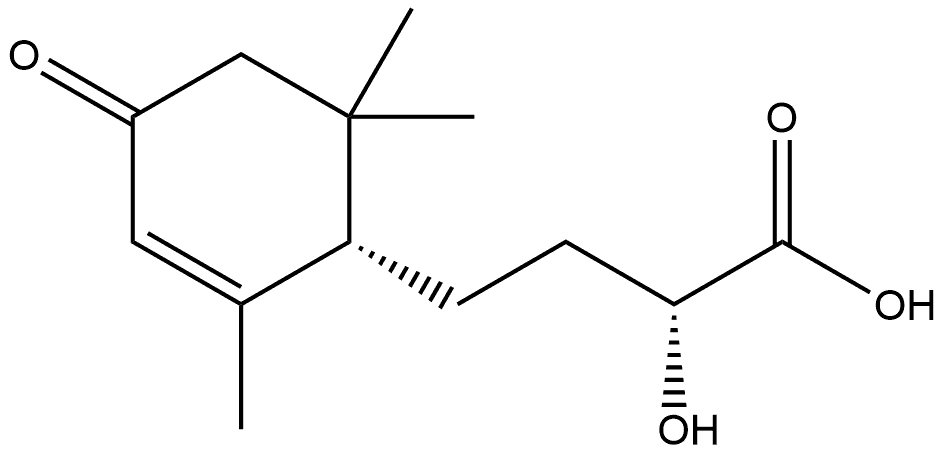(6S,9R)-2-Hydroxy-4-(2,6,6-trimethyl-4-oxo-cyclohex-2-enyl)-butyric acidCAS# 2089289-59-6 |

Quality Control & MSDS
Package In Stock
Number of papers citing our products

| Cas No. | 2089289-59-6 | SDF | Download SDF |
| PubChem ID | N/A | Appearance | Powder |
| Formula | C13H20O4 | M.Wt | 240.33 |
| Type of Compound | Monoterpenoids | Storage | Desiccate at -20°C |
| Synonyms | (αR,1S)-α-Hydroxy-2,6,6-trimethyl-4-oxo-2-cyclohexene-1-butanoic acid | ||
| Solubility | Soluble in Chloroform,Dichloromethane,Ethyl Acetate,DMSO,Acetone,etc. | ||
| General tips | For obtaining a higher solubility , please warm the tube at 37 ℃ and shake it in the ultrasonic bath for a while.Stock solution can be stored below -20℃ for several months. We recommend that you prepare and use the solution on the same day. However, if the test schedule requires, the stock solutions can be prepared in advance, and the stock solution must be sealed and stored below -20℃. In general, the stock solution can be kept for several months. Before use, we recommend that you leave the vial at room temperature for at least an hour before opening it. |
||
| About Packaging | 1. The packaging of the product may be reversed during transportation, cause the high purity compounds to adhere to the neck or cap of the vial.Take the vail out of its packaging and shake gently until the compounds fall to the bottom of the vial. 2. For liquid products, please centrifuge at 500xg to gather the liquid to the bottom of the vial. 3. Try to avoid loss or contamination during the experiment. |
||
| Shipping Condition | Packaging according to customer requirements(5mg, 10mg, 20mg and more). Ship via FedEx, DHL, UPS, EMS or other couriers with RT, or blue ice upon request. | ||

(6S,9R)-2-Hydroxy-4-(2,6,6-trimethyl-4-oxo-cyclohex-2-enyl)-butyric acid Dilution Calculator

(6S,9R)-2-Hydroxy-4-(2,6,6-trimethyl-4-oxo-cyclohex-2-enyl)-butyric acid Molarity Calculator
| 1 mg | 5 mg | 10 mg | 20 mg | 25 mg | |
| 1 mM | 4.1609 mL | 20.8047 mL | 41.6095 mL | 83.2189 mL | 104.0236 mL |
| 5 mM | 0.8322 mL | 4.1609 mL | 8.3219 mL | 16.6438 mL | 20.8047 mL |
| 10 mM | 0.4161 mL | 2.0805 mL | 4.1609 mL | 8.3219 mL | 10.4024 mL |
| 50 mM | 0.0832 mL | 0.4161 mL | 0.8322 mL | 1.6644 mL | 2.0805 mL |
| 100 mM | 0.0416 mL | 0.208 mL | 0.4161 mL | 0.8322 mL | 1.0402 mL |
| * Note: If you are in the process of experiment, it's necessary to make the dilution ratios of the samples. The dilution data above is only for reference. Normally, it's can get a better solubility within lower of Concentrations. | |||||

Calcutta University

University of Minnesota

University of Maryland School of Medicine

University of Illinois at Chicago

The Ohio State University

University of Zurich

Harvard University

Colorado State University

Auburn University

Yale University

Worcester Polytechnic Institute

Washington State University

Stanford University

University of Leipzig

Universidade da Beira Interior

The Institute of Cancer Research

Heidelberg University

University of Amsterdam

University of Auckland

TsingHua University

The University of Michigan

Miami University

DRURY University

Jilin University

Fudan University

Wuhan University

Sun Yat-sen University

Universite de Paris

Deemed University

Auckland University

The University of Tokyo

Korea University
- 5,6,7,8-Tetrahydroxy-3',4'-dimethoxyflavone
Catalog No.:BCX1995
CAS No.:2930091-30-6
- Anhydroperiplogenone
Catalog No.:BCX1994
CAS No.:1247-04-7
- Digitoxigenin glucomethyloside
Catalog No.:BCX1993
CAS No.:40950-57-0
- Strospeside
Catalog No.:BCX1992
CAS No.:595-21-1
- Quercetin-3-O-α-(6'''-caffeoylglucosyl-β-1,2-rhamnoside)
Catalog No.:BCX1991
CAS No.:851222-75-8
- Digitoxigenin monodigitoxoside
Catalog No.:BCX1990
CAS No.:18404-43-8
- Isolithospermic acid
Catalog No.:BCX1899
CAS No.:1217879-76-9
- Ipalbinium
Catalog No.:BCX1898
CAS No.:110200-24-3
- Tenuifoliose D
Catalog No.:BCX1895
CAS No.:139682-04-5
- Licorisoflavan I
Catalog No.:BCX1894
CAS No.:2444736-45-0
- 3-epi-Tilifodiolide
Catalog No.:BCX1897
CAS No.:1983982-42-8
- Genistein 7-O-β-D-glucopyranoside-4’-O-[α-L-rhamnopyranosyl-(1→2)-β-D-glucopyranoside]
Catalog No.:BCX2014
CAS No.:361447-29-2
- 5,6-Dihydroxy-8-methoxyflavone-7-O-glucuronide
Catalog No.:BCX1997
CAS No.:1169879-99-5
- 3-Hydroxy-1,2-dimethoxyxanthone
Catalog No.:BCX1998
CAS No.:20362-27-0
- 1,2,3-Trimethoxyxanthone
Catalog No.:BCX1999
CAS No.:27460-10-2
- 1-Methoxy-2,3-methylenedioxyxanthone
Catalog No.:BCX2000
CAS No.:63625-05-8
- 1,3-Dihydroxy-2-methoxyxanthone
Catalog No.:BCX2001
CAS No.:87339-74-0
- Digitalin
Catalog No.:BCX2002
CAS No.:752-61-4
- T-Muurolol
Catalog No.:BCX2003
CAS No.:19912-62-0
- T-Cadinol
Catalog No.:BCX2004
CAS No.:5937-11-1
- Paeonicluside
Catalog No.:BCX2005
CAS No.:448231-30-9
- Schiarisanrin D
Catalog No.:BCX2006
CAS No.:188943-88-6
- (-)-cis-Calamenene
Catalog No.:BCX2007
CAS No.:483-77-2
- (-)-Torreyol
Catalog No.:BCX2008
CAS No.:19435-97-3
Two new megastigmanes from Chinese traditional medicinal plant Sedum sarmentosum.[Pubmed:28152607]
Nat Prod Res. 2017 Jul;31(13):1473-1477.
To discover new bioactive compounds from nature plants, a primary screening of traditional Chinese medicines had been taken. The screening results showed that a EtOAc extract of Sedum sarmentosum displayed a certain degree of cytotoxic activity and bioassay-directed isolation of EtOAc extract gave two new megastigmanes, (6S,9R)-2-Hydroxy-4-(2,6,6-trimethyl-4-oxo-cyclohex-2-enyl)-butyric acid (1) and (6S,9R)-2-Hydroxy-4-(2,6,6-trimethyl-4-oxo-cyclohex-2-enyl)-butyric acid methyl ester (2) together with seven known flavonoids. The chemical structures of 1 and 2 were elucidated on the basis of detailed 1D, 2D NMR and MS data. When tested against HepG2 and Hep3B hepatocellular carcinoma cell lines, compounds 1-9 showed weak anti-HCC activity. In addition, in vitro antioxidant activities of 1-9 were evaluated by ABTS radical cation-scavenging assay. 1 and 2 exhibited weak activity with per micromoles equivalent to 0.039 and 0.042 muM of Trolox, respectively. The flavonoid component, quercetin (9) showed the highest antioxidant activities with per micromoles equivalent 0.67 muM of Trolox.


